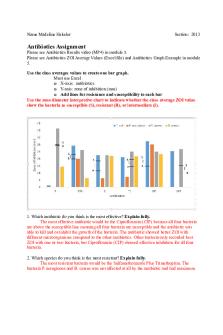OIDD 245 notes - Session 6 PDF

| Title | OIDD 245 notes - Session 6 |
|---|---|
| Course | Analytics & the Digital Economy |
| Institution | University of Pennsylvania |
| Pages | 2 |
| File Size | 97.6 KB |
| File Type | |
| Total Downloads | 70 |
| Total Views | 133 |
Summary
OIDD245 - Spring 2021 - Professor Tambe...
Description
Session 6 - Data Wrangling (Mon Feb 8th) For Big-Data Scientists, ‘Janitor Work’ Is Key Hurdle to Insights - The New York Times - “big data” : the modern abundance of digital data from many sources can be mined with clever software for discoveries and insights - smarter, data-driven decision-making in every field. - why data scientist is the economy’s hot new job. - too much handcrafted work --- “data wrangling,”“data munging”, “data janitor work” — is still required - spend from 50 percent to 80percent of their time in this more mundane labor - combining different data sets - Data from sensors, documents, the web and conventional databases all come indifferent formats - must be cleaned up and converted into a unified form that the algorithm can understand - Startups creating software tools to improve this problem - ClearStory Data - Trifacta makes a tool for data professionals - Paxata is focused squarely on automating data preparation Data Scientist: The Dirtiest Job of the 21st Century 40% a vacuum, 40% a janitor, and 20% a fortune-teller
-
Data lakes are centralised repositories that store all the company’s data. Unfortunately, some people assume that data lakes are data dumping grounds Many organisations started implementing data lakes without a clear idea of what to do with the data collected. it is still vital to design it with specific projects needs Data scientists often find themselves contacting different departments for data Merely storing data without cataloguing it is a big mistake. The key to having a useful data lake is to ensure that the metadata is well-defined. Dirty data takes away the integrity of the dataset - Incomplete data is when some essential features are empty
-
-
Inaccurate and inconsistent data is when the values are technically correct, but wrong based on the context. For example, when an employee changed his address, and it wasn’t updated. - Duplicate data the 80/20 rule. Data scientists spend only 20 percent of their time on building models and the other 80 percent gathering, analysing, cleaning, and reorganising data...
Similar Free PDFs

OIDD 245 notes - Session 6
- 2 Pages

Session 1, Module 6 Notes
- 4 Pages

6. Session
- 2 Pages

EG-111 Auto CAD notes - Session 6
- 23 Pages

Session 6-Tut (Ethics)
- 3 Pages

Session-11 - cracker notes
- 4 Pages

Session 7 - Lecture notes
- 5 Pages

pre session 89 notes
- 1 Pages

Writing TASK 1- Session 6
- 1 Pages

Item 245 – Diabète - ECN
- 15 Pages

245-CAN Centes
- 21 Pages

Session-1 - Lecture notes 1
- 4 Pages

Session 10- Guest speaker notes
- 2 Pages

Session-2 - Lecture notes 2
- 14 Pages
Popular Institutions
- Tinajero National High School - Annex
- Politeknik Caltex Riau
- Yokohama City University
- SGT University
- University of Al-Qadisiyah
- Divine Word College of Vigan
- Techniek College Rotterdam
- Universidade de Santiago
- Universiti Teknologi MARA Cawangan Johor Kampus Pasir Gudang
- Poltekkes Kemenkes Yogyakarta
- Baguio City National High School
- Colegio san marcos
- preparatoria uno
- Centro de Bachillerato Tecnológico Industrial y de Servicios No. 107
- Dalian Maritime University
- Quang Trung Secondary School
- Colegio Tecnológico en Informática
- Corporación Regional de Educación Superior
- Grupo CEDVA
- Dar Al Uloom University
- Centro de Estudios Preuniversitarios de la Universidad Nacional de Ingeniería
- 上智大学
- Aakash International School, Nuna Majara
- San Felipe Neri Catholic School
- Kang Chiao International School - New Taipei City
- Misamis Occidental National High School
- Institución Educativa Escuela Normal Juan Ladrilleros
- Kolehiyo ng Pantukan
- Batanes State College
- Instituto Continental
- Sekolah Menengah Kejuruan Kesehatan Kaltara (Tarakan)
- Colegio de La Inmaculada Concepcion - Cebu

